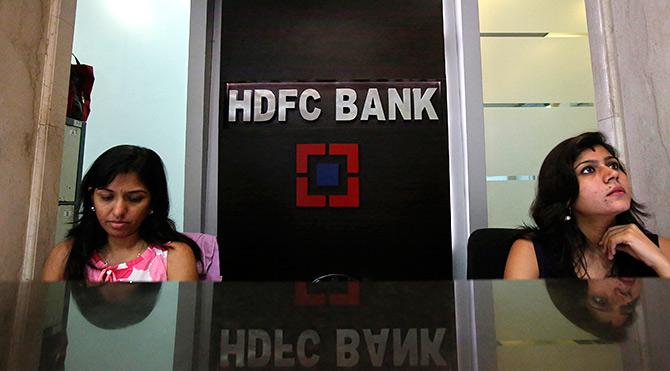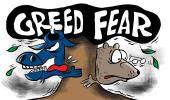Growing concerns over slower-than-expected margin recovery, amid weak deposit growth have caught HDFC Bank’s investors off guard.

HDFC Bank’s stock on Wednesday plunged nearly 9 per cent to hit an intraday low of Rs 1,527 on the BSE after reporting weaker-than-expected earnings in the third quarter (October – December) of the current financial year (Q3FY24).
The shares of India's biggest private lender closed at Rs 1,536.9, down 8.46 per cent.
Its sharpest fall before Wednesday's session was on March 23, 2020 (Covid period) when it had fallen 12.61 per cent.
HDFC Bank accounted for nearly 60 per cent of the benchmark S&P BSE Sensex's 1,628-point decline on Wednesday.
The stock also dragged the BSE Bankex index 4 per cent lower.
The decline comes as retail deposits during the October to December quarter grew 2.9 per cent quarter-on-quarter (Q-o-Q) at Rs 53,000 crore, while total deposits rose just 1.9 per cent.
The average quarterly net deposit for the nine months of FY24 (9MFY24) stood at Rs 63,600 crore, lower than the guided Rs 1 trillion target.
The loan-to-deposit (LDR) ratio increased to 110 per cent versus 107 per cent quarter-on-quarter (Q-o-Q).
The bank funded the incremental loan growth of Rs 1.15 trillion through a combination of deposit growth (Rs 41,100 crore), and reduction in investment (down Rs 48,500 crore), and cash and cash equivalent (Rs 9,600 crore).
Accordingly, the liquidity coverage ratio (LCR) has moderated from 121 per cent in Q2FY24 to 110 per cent in Q3FY24.
“With LDR at 110 per cent, the bank needs to step up deposits growth as higher LDR could constrain loan growth, in the near-medium term.
"We see a tightrope walk for HDFC Bank, as it does not want to differentiate on pricing but needs to have much faster deposit growth to sustain current loan growth,” said analysts at ICICI Securities.
On its part, the management said the deficit in system liquidity is the biggest constraint for the deposit growth.
It believes the bank is gaining incremental market share.
It also attributed the slower rate of branch expansion to weak deposit growth.
During Q3FY24, HDFC Bank’s operating expenses rose 3.6 per cent Q-o-Q, but the bank added only 146 branches and 270 in 9MFY24 against the target of 1,500.
HDFC Bank’s core net interest margin (NIM) on total assets stood at 3.4 per cent in Q3FY24, and its NIM on interest-earning assets was 3.6 per cent.
Both NIMs were steady when compared with the July-September quarter (Q2FY24).
Analysts, however, believe that despite the NIM likely bottoming out, the drivers for expansion appear to be slower than forecast.
"HDFC Bank's NIM was flat sequentially despite wearing away of the incremental cash reserve ratio (ICRR) impact and draw-down of some surplus liquidity,
resulting in higher CD ratio and lower LCR.
"While we have understood that the NIM would bottom outpost the merger, it has taken a much longer time to understand where it will settle and the pace of improvement,” said Kotak Institutional Equities.
Given the continued systemic tightness in liquidity and HDFC Bank's high ask rate concerning deposit accretion, analysts believe the improvement in HDFC Bank’s NIMs will only be gradual.
Against this backdrop, most brokerages have cut their earnings estimates for HDFC Bank.
Nuvama Institutional Equities, for instance, has cut loan and earnings per share growth estimates by 4–6 per cent. With core return on asset (RoA) of 1.7–1.8 per cent, it has downgraded the stock to 'hold'.
Those at Kotak, too, have slashed net interest income (NII) estimates by 3.7 per cent/6.7 per cent/5.8 per cent for FY24/FY25/FY26.
NIM projections, too, are down by 7bps/13bps/9bps, respectively.
“We cut FY25-26E earnings by 3 per cent, building in the growth moderation, but retain our long-term ‘buy’ with a target of Rs 2,100 as we believe the merger drag should ease gradually over FY25-26E and lead to sustained RoA/return on equity (RoE) of 1.9 per cent/16-17 per cent over FY25-26E,” said Emkay Global.
Disclaimer: This article is meant for information purposes only. This article and information do not constitute a distribution, an endorsement, an investment advice, an offer to buy or sell or the solicitation of an offer to buy or sell any securities/schemes or any other financial products/investment products mentioned in this article to influence the opinion or behaviour of the investors/recipients.
Any use of the information/any investment and investment related decisions of the investors/recipients are at their sole discretion and risk. Any advice herein is made on a general basis and does not take into account the specific investment objectives of the specific person or group of persons. Opinions expressed herein are subject to change without notice.












 © 2025
© 2025